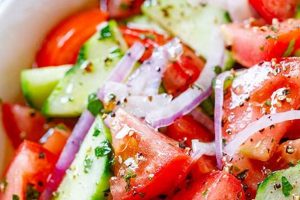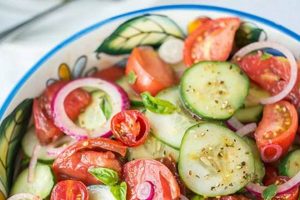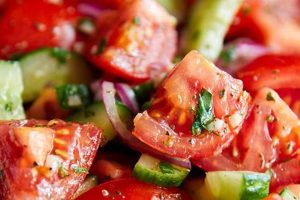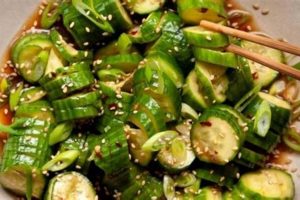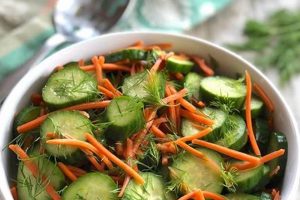A defining element of many cucumber salads is the acidic component provided by vinegar. This ingredient not only preserves the crispness of the cucumbers but also adds a bright, tangy flavor that balances the vegetable’s subtle sweetness. Various types, such as white vinegar, apple cider vinegar, or rice vinegar, can be used, each contributing unique nuances to the final dish. A simple preparation might involve sliced cucumbers marinated in a mixture of vinegar, sugar, salt, and perhaps a touch of dill or other herbs.
The use of an acidic marinade in cucumber salads offers several advantages. Historically, vinegar played a crucial role in food preservation before refrigeration. Today, it continues to extend the shelf life of prepared salads. Furthermore, the acidic environment created by the vinegar enhances the vibrant green color of the cucumbers, making the salad visually appealing. The balance of sweet, salty, and acidic flavors creates a refreshing and palate-cleansing dish, ideal as a light side or part of a larger meal.
This exploration of the role of vinegar in cucumber salads will further examine different vinegar varieties, their impact on flavor profiles, and techniques for achieving perfectly balanced and delicious results. Additional topics will cover complementary ingredients, variations in preparation methods, and suggestions for serving.
Tips for Utilizing Vinegar in Cucumber Salads
Achieving a well-balanced and flavorful cucumber salad hinges on the thoughtful selection and application of vinegar. These tips offer guidance for optimizing its use.
Tip 1: Vinegar Selection: Different vinegars impart distinct flavor profiles. White vinegar offers a clean, sharp acidity, while apple cider vinegar contributes a subtle sweetness. Rice vinegar lends a milder, slightly sweet note. Match the vinegar to the desired overall flavor profile of the salad.
Tip 2: Balancing Flavors: Balance the acidity of the vinegar with other ingredients. Sugar or honey tempers sharpness, while salt enhances overall flavor and draws moisture from the cucumbers.
Tip 3: Marinating Time: Marinating time influences the cucumber’s texture and flavor absorption. Brief marinades (15-30 minutes) maintain crispness, while longer periods result in softer cucumbers and more pronounced vinegar flavor.
Tip 4: Slicing Techniques: Thinly sliced cucumbers absorb flavors more readily than thicker slices. Consider using a mandoline for uniform slices, ensuring even marination.
Tip 5: Enhancing with Herbs and Spices: Fresh dill, mint, or parsley complement the bright flavors of cucumber and vinegar. A pinch of black pepper or red pepper flakes can add a subtle layer of complexity.
Tip 6: Temperature Considerations: Serving temperature impacts the salad’s overall experience. A chilled cucumber salad offers a refreshing contrast, particularly in warmer weather.
Tip 7: Avoiding Over-Marinating: Over-marinating can lead to excessively soft cucumbers and an overpowering vinegar taste. Monitor the marinating process and adjust the time as needed.
By considering these tips, one can elevate a simple cucumber salad to a flavorful and refreshing dish. The thoughtful application of vinegar enhances both the taste and texture, resulting in a more enjoyable culinary experience.
These practical insights provide a foundation for crafting exceptional cucumber salads. The following section will offer a variety of specific recipe examples to further illustrate these principles.
1. Cucumber Variety
Cucumber variety constitutes a significant factor in the ultimate success of a vinegar-based cucumber salad. The cucumber’s inherent characteristics, including water content, skin thickness, and seed size, interact directly with the vinegar marinade, influencing both flavor and texture. Selecting the appropriate cucumber variety is therefore essential for achieving the desired outcome.
- Water Content and Texture
Cucumbers with higher water content, such as standard slicing cucumbers, tend to release more liquid when exposed to an acidic marinade. This can lead to a watery salad if not properly addressed. Varieties like Persian cucumbers, with lower water content, maintain better texture during marination. Recipe adjustments, such as salting cucumbers before marinating, can mitigate excess moisture.
- Skin Thickness and Flavor Absorption
Thin-skinned cucumbers, like English or Persian varieties, absorb flavors more readily than thick-skinned slicing cucumbers. This allows the vinegar and other seasonings to penetrate more deeply, resulting in a more pronounced flavor profile. Thick-skinned cucumbers may require a longer marinating time or a more intensely flavored marinade to achieve comparable results.
- Seed Size and Overall Palate
Large seeds can contribute a slightly bitter flavor and detract from the overall delicacy of the salad. Seedless or small-seeded varieties, like English cucumbers, offer a more refined eating experience. Removing seeds from standard slicing cucumbers can improve texture and minimize potential bitterness.
- Cucumber Size and Shape
The size and shape of the cucumber dictate slicing options and presentation. Longer, slender cucumbers are ideal for thin ribbons or rounds, while smaller, stubbier varieties might be better suited for chunkier salads. Uniform slicing ensures even marination and consistent flavor throughout the salad.
The interplay between cucumber variety and the vinegar marinade is critical. Understanding these nuances allows for informed decisions when selecting cucumbers and adjusting recipes to achieve specific flavor and texture goals. The optimal cucumber choice depends on the desired outcome a crisp, refreshing salad or a softer, more intensely flavored dish. By considering these factors, one can elevate a simple cucumber salad to a culinary masterpiece.
2. Vinegar Type
Vinegar type plays a pivotal role in defining the character of a cucumber salad. The choice of vinegar significantly impacts the overall flavor profile, influencing the balance between sweetness, acidity, and other nuanced notes. Different vinegars possess distinct characteristics derived from their source and production methods. This inherent variety allows for a wide range of flavor possibilities within the seemingly simple cucumber salad.
For instance, distilled white vinegar offers a clean, sharp acidity that provides a crisp counterpoint to the cucumber’s subtle sweetness. This type of vinegar is particularly effective in salads emphasizing a refreshing, palate-cleansing quality. Conversely, apple cider vinegar introduces a mellower acidity with hints of apple sweetness, adding depth and complexity. This choice complements salads incorporating ingredients like onions or herbs. Rice vinegar, known for its mild and slightly sweet flavor, lends a delicate touch, particularly suitable for salads with Asian-inspired flavor profiles. The choice between these and other varieties, such as balsamic or red wine vinegar, should be guided by the intended balance of flavors in the finished dish.
Understanding the nuances of each vinegar type empowers informed decision-making when crafting cucumber salads. Consideration of the vinegar’s acidity level, sweetness, and potential complementary flavors is paramount. A successful cucumber salad recipe hinges on the harmonious interplay between the chosen vinegar and other ingredients. Experimentation with different vinegar types expands the culinary possibilities and allows for the creation of unique and personalized flavor experiences. This knowledge facilitates a deeper appreciation of the multifaceted role of vinegar in culinary applications.
3. Sweetener Choice
Sweetener choice represents a crucial element within vinegar-based cucumber salad recipes. The sweetener’s primary function is to balance the acidity of the vinegar, preventing an overly tart flavor profile. However, its role extends beyond mere counterbalance. Sweeteners contribute to the overall complexity of the salad, influencing texture and interacting with other ingredients. The specific sweetener selected impacts not only the perceived sweetness but also the final flavor profile and mouthfeel.
Granulated sugar offers a straightforward approach, providing clean sweetness and readily dissolving into the vinegar marinade. Its neutral flavor allows the other ingredients, like herbs and spices, to shine. Honey, on the other hand, introduces a more complex sweetness with subtle floral or herbal notes, depending on the variety. Honey also contributes a slightly thicker consistency to the marinade, which can coat the cucumbers more effectively. Alternative sweeteners like maple syrup or agave nectar offer distinct flavor profiles and can align with specific dietary preferences. Agave, for example, tends to be milder than honey, while maple syrup imparts a characteristic woody sweetness. The concentration of the sweetener, whether a light touch or a more pronounced sweetness, further shapes the final flavor balance. Salads with delicate herbs might benefit from a subtler sweetener, while those featuring bolder flavors can tolerate a more assertive sweetness.
Careful sweetener selection hinges on understanding its interaction with the chosen vinegar and other ingredients. A delicate rice vinegar paired with a subtle sweetener like agave creates a different experience compared to a robust apple cider vinegar balanced with honey. This interplay underscores the sweetener’s significance in achieving a harmonious flavor profile. Consideration of the overall recipe context, including the presence of other sweet or savory elements, ensures the sweetener contributes effectively to the final balance and complexity of the cucumber salad. Informed choices regarding sweetener type and concentration elevate the dish beyond mere simplicity, transforming it into a nuanced and flavorful culinary creation.
4. Additional Flavorings
Additional flavorings constitute a critical component of vinegar-based cucumber salads, transforming a simple dish into a complex culinary experience. These additions build upon the foundation of vinegar and sweetener, introducing layers of aromatic complexity and textural nuance. The strategic incorporation of herbs, spices, and other flavoring agents elevates the cucumber salad from refreshing simplicity to a more sophisticated and satisfying culinary creation.
- Fresh Herbs
Fresh herbs provide a bright, vibrant dimension to cucumber salads. Dill, with its delicate anise-like flavor, is a classic pairing, complementing the cucumber’s subtle sweetness and the vinegar’s tang. Mint offers a refreshing coolness, while parsley contributes a clean, herbaceous note. Chives provide a mild onion flavor, and cilantro introduces a citrusy zest. The choice of herb depends on the desired overall flavor profile and can be tailored to complement other ingredients.
- Spices
Spices introduce warmth and depth. Black pepper provides a subtle bite, enhancing the other flavors without overpowering the delicate cucumber. Red pepper flakes add a touch of heat, while a pinch of celery seed or coriander can introduce unexpected complexity. Ground ginger or cumin, used sparingly, can create unique flavor profiles, particularly in salads with Asian or Middle Eastern influences.
- Alliums
Alliums, such as thinly sliced red onion or minced shallots, contribute a pungent sharpness that complements the cucumber and vinegar. Their sulfurous compounds add a savory depth and textural contrast. Garlic, used judiciously, provides a pungent bite. The intensity of alliums can be adjusted by soaking them in cold water to mellow their sharpness before adding them to the salad.
- Other Flavoring Agents
Beyond herbs and spices, other ingredients can enhance the complexity of the cucumber salad. A splash of sesame oil adds a nutty richness, while a squeeze of lemon or lime juice provides a citrusy brightness. Toasted sesame seeds offer a textural element and a nutty flavor. A small amount of grated ginger adds a spicy warmth. These additions provide further opportunities for customization and experimentation.
The interplay between these additional flavorings and the core elements of vinegar and sweetener defines the character of the cucumber salad. A thoughtful combination of fresh herbs, spices, alliums, and other flavoring agents elevates the dish from simple to sophisticated. Careful consideration of flavor pairings and balance ensures a harmonious and satisfying culinary experience. By understanding the nuances of each ingredient and its interaction with others, one can craft a cucumber salad that is both refreshing and complex, a true testament to the power of thoughtful flavor combinations.
5. Marinating Time
Marinating time represents a critical factor in vinegar-based cucumber salad recipes. Duration significantly influences the final texture and flavor profile of the cucumbers. The interaction between the acidic marinade and the cucumber’s cellular structure changes over time, affecting both crispness and the degree of flavor penetration. Understanding these temporal dynamics is essential for achieving desired outcomes.
- Short Marinades (15-30 minutes)
Brief exposure to the vinegar marinade results in a crisp, refreshing salad. The cucumbers retain their structural integrity, offering a satisfying crunch. Flavor penetration remains limited to the surface, providing a bright, tangy counterpoint to the cucumber’s natural sweetness. This approach suits salads emphasizing texture and a lighter vinegar presence.
- Medium Marinades (30-60 minutes)
Extending the marinating time allows for greater flavor absorption. The vinegar permeates the cucumber more deeply, resulting in a more pronounced tangy flavor. Texture begins to soften slightly, offering a balance between crispness and tenderness. This timeframe often provides an optimal balance for many palates, delivering both flavor and textural complexity.
- Long Marinades (1-2 hours)
Longer marinades result in significantly softer cucumbers, as the vinegar continues to break down cell walls. Flavor penetration intensifies, resulting in a more pronounced acidic presence. This approach suits dishes where a softer texture and a more intense vinegar flavor are desired, such as in some regional variations or when incorporating the marinated cucumbers into other recipes.
- Extended Marinades (Beyond 2 hours)
While possible, marinating beyond two hours often leads to excessively soft, almost pickled cucumbers. The texture can become mushy, and the vinegar flavor may overpower other nuances. This approach suits specific culinary applications where a pickled texture is desirable but is generally not recommended for traditional cucumber salads aiming for a balance of flavor and crispness.
The interplay between marinating time and the desired cucumber salad characteristics is fundamental to recipe development. Selection of the appropriate duration depends on the intended balance of texture and flavor. A clear understanding of these temporal effects empowers informed decision-making and allows for precise control over the final product. This knowledge translates directly to the ability to consistently create cucumber salads that meet specific culinary objectives, whether emphasizing crispness, intense flavor, or a specific textural profile.
Frequently Asked Questions
This section addresses common inquiries regarding the preparation of vinegar-based cucumber salads, offering practical insights and clarifying potential points of confusion. Understanding these nuances allows for greater control over the final product and facilitates consistent, successful outcomes.
Question 1: What type of vinegar is best suited for cucumber salad?
The ideal vinegar depends on the desired flavor profile. Distilled white vinegar provides a clean, sharp acidity. Apple cider vinegar offers a milder tang with subtle sweetness. Rice vinegar contributes a mild, slightly sweet flavor. Experimentation is encouraged to determine personal preference.
Question 2: How can excess moisture in cucumber salad be prevented?
Salting sliced cucumbers prior to marinating draws out excess moisture. Allow the salted cucumbers to rest for 15-30 minutes, then pat dry before adding the vinegar mixture. Selecting cucumber varieties with lower water content, such as Persian cucumbers, can also mitigate this issue.
Question 3: What is the ideal marinating time for cucumber salad?
Marinating time influences both texture and flavor. Short marinades (15-30 minutes) maintain crispness, while longer periods (1-2 hours) result in softer cucumbers and more pronounced vinegar flavor. Over-marinating can lead to excessively soft cucumbers.
Question 4: Can sugar be substituted with other sweeteners?
Sugar can be replaced with honey, maple syrup, or agave nectar. Each alternative sweetener introduces unique flavor nuances. Adjust the quantity according to the sweetener’s relative sweetness and the desired flavor profile.
Question 5: How can the sharpness of raw onions in cucumber salad be tempered?
Soaking thinly sliced onions in cold water for 10-15 minutes mellows their pungency. This step reduces the intensity of raw onion flavor while maintaining its textural contribution to the salad.
Question 6: How should cucumber salad be stored?
Store cucumber salad in an airtight container in the refrigerator. Consume within 2-3 days for optimal quality. The texture and flavor may change over time as the cucumbers continue to release moisture and absorb the marinade.
Addressing these common queries provides a comprehensive understanding of the key considerations for successful cucumber salad preparation. Attention to vinegar selection, moisture control, marinating time, sweetener choice, and flavor balancing ensures a consistently delicious and refreshing culinary experience.
The following section will offer a curated selection of diverse cucumber salad recipes, showcasing the practical application of these principles and demonstrating the versatility of this simple yet satisfying dish.
Recipe Cucumber Salad Vinegar
Vinegar-based cucumber salads, seemingly simple, offer a canvas for culinary creativity. Careful consideration of cucumber variety, vinegar type, sweetener choice, additional flavorings, and marinating time yields diverse flavor profiles and textures. Achieving optimal results requires understanding the interplay of these elements. Balancing acidity, sweetness, and complementary flavors transforms a basic preparation into a nuanced and refreshing dish.
Exploration of these facets expands culinary horizons, enabling adaptation and personalization of recipes. Continued experimentation with flavor combinations and techniques unlocks the full potential of this versatile dish. The foundational principles outlined herein provide a framework for crafting exceptional cucumber salads, encouraging culinary innovation and a deeper appreciation for the art of balancing flavors.

